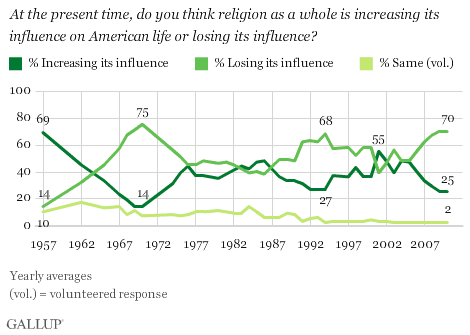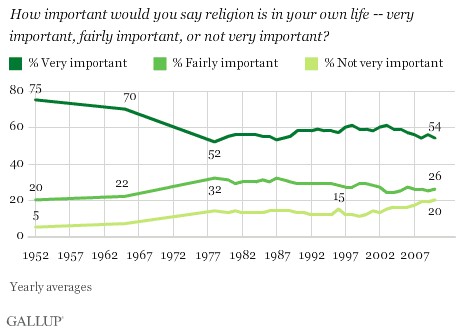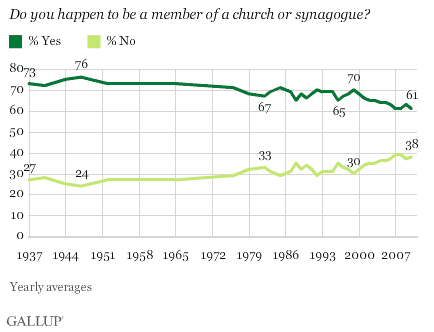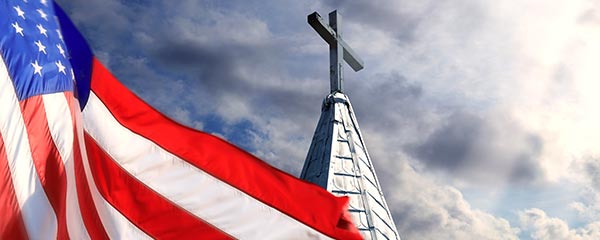PRINCETON, NJ -- Seven in 10 Americans say religion is losing its influence on American life -- one of the highest such responses in Gallup's 53-year history of asking this question, and significantly higher than in the first half of the past decade.

Americans' views of the influence of religion in the U.S. have fluctuated substantially in the years since 1957, when Gallup first asked this question. At that point, perhaps reflecting the general focus on family values that characterized the Eisenhower era, 69% of Americans said religion was increasing its influence, the most in Gallup's history.
Views of the influence of religion shifted dramatically in the mid-1960s. By 1970, in the midst of the protests over the Vietnam War and general social upheaval, a record 75% of Americans said religion was losing influence in American society. These views moderated in the years thereafter. At several points during the Reagan administration, a plurality of Americans returned to the view that religion was increasing its influence. By the early 1990s, Americans became more convinced again that religion was losing its influence. These views persisted until a sharp reversal after the Sept. 11, 2001, terrorist attacks, when a number of social and political indicators, including presidential and congressional approval and overall satisfaction with the way things were going, showed substantial increases.
Views that religion was increasing in influence began to fade in the second half of the last decade. The 7 in 10 Americans who now say religion is losing its influence is tied with 2009 for the most who have held such a view since 1970.
Personal Importance of Religion Broadly Stable in Recent Years
Americans' views about the influence of religion in their own lives have been considerably more stable over the past six or seven decades than their views about the influence of religion on American society.
Fifty-four percent of Americans in 2010 say religion is "very important" in their lives. This is down slightly from the past two decades, but roughly equal with levels measured in the 1980s. Americans were much more positive about the effect of religion on their own lives in the 1950s and 1960s, including the historic high of 75% who said religion was very important in 1952.

Church and Synagogue Membership Reflects Slow Decline
Self-reported church or synagogue membership has drifted slowly downward over the past 70 years. The current 61% of Americans who report church or synagogue membership is tied with 2007 and 2008 as the lowest in Gallup's history and down significantly from a high of 76% in 1947.

Implications
When Gallup asks Americans to opine about the influence of religion on American society in general, they most likely take into account a wide variety of social, political, and economic factors in arriving at their responses. Although views that religion was increasing its influence were highest during the Republican administrations of Eisenhower, Reagan, and George W. Bush, this political connection does not appear to be the primary explanatory factor. Views on the increasing influence of religion were quite low during the Republican administrations of Richard Nixon and George H.W. Bush.
Gallup's trends reflecting more personal views of religion do not show the same patterns of fluctuation as the broader questions about American society. What trends there are provide a somewhat mixed message. While almost all measures show that Americans were more religious in the 1940s and 1950s than in recent decades, Americans appear to be as personally religious now as they were in the late 1970s and 1980s. Church and synagogue membership, on the other hand, has drifted downward in a more steady fashion. The current 61% of Americans who report being a church or synagogue member is as low as has been measured by Gallup since the 1930s.
Survey Methods
Results for the 2010 Gallup poll aggregate are based on telephone interviews conducted May 3-6 and Dec. 10-12, 2010, with a random sample of 2,048 adults, aged 18 and older, living in all 50 U.S. states and the District of Columbia, selected using random-digit-dial sampling.
For results based on the total sample of national adults, one can say with 95% confidence that the maximum margin of sampling error is ±3 percentage points.
Interviews are conducted with respondents on landline telephones and cellular phones, with interviews conducted in Spanish for respondents who are primarily Spanish-speaking. Each daily sample includes a minimum quota of 150 cell phone respondents and 850 landline respondents, with additional minimum quotas among landline respondents for gender within region. Landline respondents are chosen at random within each household on the basis of which member had the most recent birthday.
Samples are weighted by gender, age, race, Hispanic ethnicity, education, region, adults in the household, cell phone-only status, cell phone-mostly status, and phone lines. Demographic weighting targets are based on the March 2009 Current Population Survey figures for the aged 18 and older non-institutionalized population living in U.S. telephone households. All reported margins of sampling error include the computed design effects for weighting and sample design.
In addition to sampling error, question wording and practical difficulties in conducting surveys can introduce error or bias into the findings of public opinion polls.
View methodology, full question results, and trend data.
For more details on Gallup's polling methodology, visit https://www.gallup.com/.
